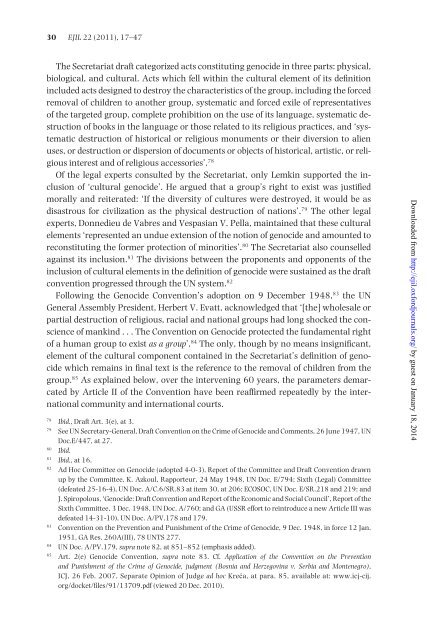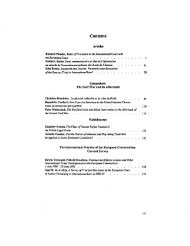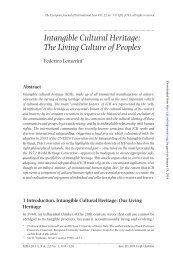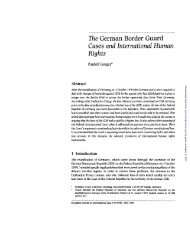Genocide and Restitution - European Journal of International Law
Genocide and Restitution - European Journal of International Law
Genocide and Restitution - European Journal of International Law
You also want an ePaper? Increase the reach of your titles
YUMPU automatically turns print PDFs into web optimized ePapers that Google loves.
30 EJIL 22 (2011), 17–47<br />
The Secretariat draft categorized acts constituting genocide in three parts: physical,<br />
biological, <strong>and</strong> cultural. Acts which fell within the cultural element <strong>of</strong> its definition<br />
included acts designed to destroy the characteristics <strong>of</strong> the group, including the forced<br />
removal <strong>of</strong> children to another group, systematic <strong>and</strong> forced exile <strong>of</strong> representatives<br />
<strong>of</strong> the targeted group, complete prohibition on the use <strong>of</strong> its language, systematic destruction<br />
<strong>of</strong> books in the language or those related to its religious practices, <strong>and</strong> ‘systematic<br />
destruction <strong>of</strong> historical or religious monuments or their diversion to alien<br />
uses, or destruction or dispersion <strong>of</strong> documents or objects <strong>of</strong> historical, artistic, or religious<br />
interest <strong>and</strong> <strong>of</strong> religious accessories’. 78<br />
Of the legal experts consulted by the Secretariat, only Lemkin supported the inclusion<br />
<strong>of</strong> ‘cultural genocide’. He argued that a group’s right to exist was justified<br />
morally <strong>and</strong> reiterated: ‘If the diversity <strong>of</strong> cultures were destroyed, it would be as<br />
disastrous for civilization as the physical destruction <strong>of</strong> nations’. 79 The other legal<br />
experts, Donnedieu de Vabres <strong>and</strong> Vespasian V. Pella, maintained that these cultural<br />
elements ‘represented an undue extension <strong>of</strong> the notion <strong>of</strong> genocide <strong>and</strong> amounted to<br />
reconstituting the former protection <strong>of</strong> minorities’. 80 The Secretariat also counselled<br />
against its inclusion. 81 The divisions between the proponents <strong>and</strong> opponents <strong>of</strong> the<br />
inclusion <strong>of</strong> cultural elements in the definition <strong>of</strong> genocide were sustained as the draft<br />
convention progressed through the UN system. 82<br />
Following the <strong>Genocide</strong> Convention’s adoption on 9 December 1948, 83 the UN<br />
General Assembly President, Herbert V. Evatt, acknowledged that ‘[the] wholesale or<br />
partial destruction <strong>of</strong> religious, racial <strong>and</strong> national groups had long shocked the conscience<br />
<strong>of</strong> mankind . . . The Convention on <strong>Genocide</strong> protected the fundamental right<br />
<strong>of</strong> a human group to exist as a group’. 84 The only, though by no means insignificant,<br />
element <strong>of</strong> the cultural component contained in the Secretariat’s definition <strong>of</strong> genocide<br />
which remains in final text is the reference to the removal <strong>of</strong> children from the<br />
group. 85 As explained below, over the intervening 60 years, the parameters demarcated<br />
by Article II <strong>of</strong> the Convention have been reaffirmed repeatedly by the international<br />
community <strong>and</strong> international courts.<br />
78<br />
Ibid., Draft Art. 3(e), at 3.<br />
79<br />
See UN Secretary-General, Draft Convention on the Crime <strong>of</strong> <strong>Genocide</strong> <strong>and</strong> Comments, 26 June 1947, UN<br />
Doc.E/447, at 27.<br />
80<br />
Ibid.<br />
81<br />
Ibid., at 16.<br />
82<br />
Ad Hoc Committee on <strong>Genocide</strong> (adopted 4-0-3), Report <strong>of</strong> the Committee <strong>and</strong> Draft Convention drawn<br />
up by the Committee, K. Azkoul, Rapporteur, 24 May 1948, UN Doc. E/794; Sixth (Legal) Committee<br />
(defeated 25-16-4), UN Doc. A/C.6/SR.83 at item 30, at 206; ECOSOC, UN Doc. E/SR.218 <strong>and</strong> 219; <strong>and</strong><br />
J. Spiropolous, ‘<strong>Genocide</strong>: Draft Convention <strong>and</strong> Report <strong>of</strong> the Economic <strong>and</strong> Social Council’, Report <strong>of</strong> the<br />
Sixth Committee, 3 Dec. 1948, UN Doc. A/760; <strong>and</strong> GA (USSR effort to reintroduce a new Article III was<br />
defeated 14-31-10), UN Doc. A/PV.178 <strong>and</strong> 179.<br />
83<br />
Convention on the Prevention <strong>and</strong> Punishment <strong>of</strong> the Crime <strong>of</strong> <strong>Genocide</strong>, 9 Dec. 1948, in force 12 Jan.<br />
1951, GA Res. 260A(III), 78 UNTS 277.<br />
84<br />
UN Doc. A/PV.179, supra note 82, at 851–852 (emphasis added).<br />
85<br />
Art. 2(e) <strong>Genocide</strong> Convention, supra note 83. Cf. Application <strong>of</strong> the Convention on the Prevention<br />
<strong>and</strong> Punishment <strong>of</strong> the Crime <strong>of</strong> <strong>Genocide</strong>, judgment (Bosnia <strong>and</strong> Herzegovina v. Serbia <strong>and</strong> Montenegro),<br />
ICJ, 26 Feb. 2007, Separate Opinion <strong>of</strong> Judge ad hoc Kreća, at para. 85, available at: www.icj-cij.<br />
org/docket/files/91/13709.pdf (viewed 20 Dec. 2010).<br />
Downloaded from http://ejil.oxfordjournals.org/ by guest on January 18, 2014








